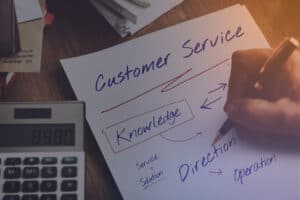- The Importance of Client Segmentation
- How are Segmentation and CRM Related?
- CRM and Scoring
Categorizing clients into distinct groups based on various criteria leads to more tailored offers and communication strategies. CRM helps organize clients and apply scoring techniques for improved customer management.
The Importance of Client Segmentation
And what are the benefits of a CRM in this case.
Segmentation in marketing, as detailed in the Solutions Metrix article, is about classifying clients based on a precise list of objective criteria. This process not only helps in understanding different customer types but also in adjusting offers and messages for each segment. This strategy is a key part of realizing CRM profit, as it aims to reduce failure and maximize the benefits of using a CRM.
How are Segmentation and CRM Related?
Link your CRM to a detailed and well-designed sales strategy and you will be able to develop, search, and award your best clients.

Organizing your clients according to where they are in the sales process will optimize your sales cycle. That is why use a CRM tool. Companies that succeed understand how important it is to step to the right timing during the decision-making process of the buyer, and to make it as easy as possible for the client.
Here is an example of the way your customers could be categorized via CRM system by using the typical selling process:
A lead: it’s a client whom you haven’t talked to yet, but who could be a potential buyer.
A prospect: it’s someone interested in your product. You’ve already been in touch once.
A guaranteed prospect: not yet a client, but you are sure that he’s about to buy your product. You simply need to finalize the sale. Segregating the guaranteed prospect of a prospect that hasn’t yet received your offer will help you save a lot of time.
A client: all the people that have already bought your product.
It is also true that, with CRM technology, you can compile all sorts of data about your clients. However, collecting relevant information requires thought and careful preparation.
The first step through identifying your most profitable client is to know why they buy your product and services. CRM records have account management functionalities that can include a personalized model with which a sales representative can classify by category if the purchase was based on a special offer, a visit, or geographical proximity.
Are CRMs worth the investment? Your CRM system also has to provide details describing if the purchase requires not a follow-up (training or maintenance work, for example), if a minimum contact with the client is necessary, or if there is a risk that the buying will not happen again for a long period. This information is crucial because it helps to assess the profitability of the clients through better control of the acquisition and maintenance costs.
CRM tools are helping you to follow up your key customers for them to be automatically lead towards a special page with relevant offers when they visit your website. At the call center, you can even routes your best clients through your customer service or first choice offer in order to provide the best possible service. The same care can be provided to clients that fit within the type of profile that you have targeted even if they don’t represent a significant turnover.
The CRM software can also assess if clients answer better to visits, web offers, online presentations, emailing campaign or other approaching methods. A good start to reduce sales costs.
CRM tools that are adopted by a company depends on a lot, to its size, to the complexity of its IT system, and to the volume of its client base (big or small) to be followed up by a sale and basic turnover report. However, any company that takes the initiative to implement better strategies to benefit even more of its clients will gain something. These strategies are also profitable for clients. They show how the company is worried about them and the way to serve them.
CRM and Scoring
Scoring techniques help you to eliminate customers that are not profitable, to nurture the best ones, assigning a score to each client. They complement traditional segmentation techniques.
 It has to include both explicit and implicit criteria, as much as compartmental ones that are crucial to identify what motivates the purchase of the leads, for example:
It has to include both explicit and implicit criteria, as much as compartmental ones that are crucial to identify what motivates the purchase of the leads, for example:
- The function or the role of the contact;
- The size of the company;
- The capital;
- The industry;
- The type of expected product;
- The budget;
- The expected delivery date.
 You also have to plan activity or behavioral criteria, for example:
You also have to plan activity or behavioral criteria, for example:
- The number of filled in form;
- The number of downloads;
- The number of read e-mails;
- The time since the last contact;
- The origin of the lead;
Each criteria will be given several points out of 100. For example, if you target, in priority, companies from the agro-food industry with 50 employees, you can assign 10 points to a company with more than 50 employees, as well as 10 points to a company from the targeted sector.
 Furthermore, this scoring system can be used for your prospects and clients. It allows you to prioritize leads and client follow-ups for secondary purchases.
Furthermore, this scoring system can be used for your prospects and clients. It allows you to prioritize leads and client follow-ups for secondary purchases.
But the quality of scoring depends on the chosen model and the relevancy of the criteria that are being used, but also especially on the available customers’ data of your CRM. And the more you feed your CRM with data, the higher the chance for your scoring to reflect the real and updated “value” of your clients.
Therefore it is important to feed your CRM with recent customers’ data. Thanks to today’s technology, you can use clients’ forms to get qualified and precise data about your clients.
Be careful not to over-solicit your clients, who can easily get bored. Knowing your clients also means to know where to position yourself and be balanced, to not end up invading them too much, which can sometimes scare people. You would then obtain the opposite effect and risk losing the ones that trust you. This is one more reason why using a CRM tool in customer segmentation is CRM worth it.
